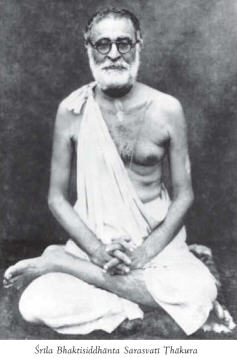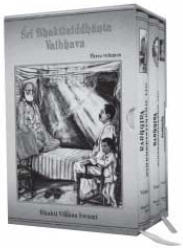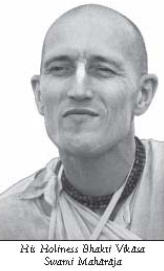An interview with Bhakti Vikasa Swami reveals how much time and effoort was put into making the biography of one of the greatest spiritual leaders of India.

Srila Bhaktisiddhanta Sarasvati Thakura (1874 1937) was the spiritual master of His Divine Grace A.C. Bhaktivedanta Swami Srila Prabhupada, the founder acharya of ISKCON. It was Srila Bhaktisiddhanta Sarasvati Thakura who gave Srila Prabhupada, in their very first meeting in 1922, the mandate to preach Krishna consciousness all over the world and thus became the inspiration for Srila Prabhupada’s eventual establishment of ISKCON.
Srila Bhaktisiddhanta Sarasvati Thakura was a towering spiritual personality, an empowered acharya, who built temples all over India, wrote several books, authored and edited scores of articles in his several magazines, initiated several thousand disciples and overall altered the course of religious history by reviving and forcefully propagating Krishna consciousness.
His Holiness Bhakti Vikasa Swami Maharaja, a sannyasi disciple of Srila Prabhupada and ISKCON guru, invested over twenty years of research to bring out a new, extensive biography that is actually a devotional, philosophical, cultural, and historical study centered on Srila Bhaktisiddhanta Sarasvati Thakura. Entitled Sri Bhakti siddhanta Vaibhava, this biography is replete with anecdotes told by disciples who lived with Srila Bhaktisiddhanta Sarasvati Thakura and extends over three hardbound volumes, totals over 1500 pages, and features 164 black and white photos (many republished after more than seventy years) and nine color photos.
Volume One features a biographical overview, plus a detailed analysis of the message, mission, and personality of Srila Bhaktisiddhanta Sarasvati.
Volume Two details the preaching challenge that Srila Bhaktisiddhanta Sarasvati faced, and also includes biographical sketches of several of his disciples and associates.
Volume Three features an overview of Srila Bhaktisiddhanta Sarasvati’s contributions, with selections from his lectures, writings, and colloquies.
Here we present an interview with His Holiness Bhakti Vikasa Swami Maharaja:
1) Maharaja, this book is a magnum opus spanning three large volumes. ‘Magnum Opus’ Can you please tell me how you got the idea and inspiration to do such a huge book?
The answer to that is treated in the preface: I didn’t have any idea to do such a big work. My original idea was to collect unrecorded anecdotes of Bhaktisiddhanta Sarasvati Thakura’s pastimes from his still remaining disciples. I got the idea to do this in 1985 when there were quite few of his disciples present in the world. So, I was based in Bangladesh and time to time I came to India and ran around in different places in Bengal and Orissa and tried to find his disciples. That was my idea and I collected some anecdotes.
And how did it become such big book? It wasn’t my idea. I just found different sources of information here and there at different times and I incorporated them and then it gradually grew. And three volumes . . . that was just practical to sort out the topics in different ways. The book took a life of itself. Literally thousands of hours of work went into it by myself particularly and also Guru Krishna Prabhu, the editor. Many others also helped in various ways. I probably wouldn’t have done it if I had known how much work it would come to be. But, at the same time, I am glad I did do it. And it has given me inspiration to do so much more.
2) Many devotees may feel overwhelmed by the size of the book. Can you share some points that will inspire them to read the book?
I am sorry that it is so small. I considered it too big a job for myself to translate everything that I had on hand. So, I just made a small book; I am sorry for making such a small book. And I pray that in the not too distant future, devotees will translate all the extant works of Srila Bhaktisiddhanta Sarasvati Thakura. And you never know someone might discover more. Lots of them are missing and reputed to be destroyed. But they may come to light. Please read the book, even though it is so small; it’s a good introduction.
3) The book seems to be written in somewhat abstruse English. Was there any specific reason for adopting this style of writing?

As I also wrote in the introduction, I chose to use somewhat abstruse English or quite a number of words that are not in common parlance. One reason is to be in tone with the style of Bhaktisiddhanta Sarasvati Thakura himself. Srila Prabhupada was different from Bhaktisiddhanta Sarasvati Thakura, not in essence but in style of presentation. Prabhupada, although very regal and aristocratic in many ways, was also very accommodating; he made Krishna consciousness seem very easy and natural for everyone in any status of life. On the other hand, Bhaktisiddhanta Sarasvati’s style wrote a lot about his linguistic style in the book was challenging. His approach was to exhort others: “Come up! Come up to the standard in every way, even linguistically.”
So, in the English language, like in most other languages, there are many more words than what most people use. There are many words which are used mostly only by intellectuals not necessarily to show off one’s intellectualism, but because every different word has different nuance of meaning and some words precisely describe specific concepts which are required when discussing intellectual topics. Bhaktisiddhanta Sarasvati Thakura of course was very much on the intellectual plane. So, if those words are there, why should they be used only by deluded mundane intellectuals? Why shouldn’t devotees use them for describing Krishna Consciousness?
After all, the inspiration to speak comes from Krsna. How is that a child learns to speak? It’s almost like a mystic process that is analyzed in modern science of linguistics. Let’s say some word: cow. Alright, I just said the word cow and you pictured in your mind a cow. Right? You have a general idea of what a cow is. So, there is a general go jati or the categories of cows. Now, how does that sound become identified with the concept of a cow not a specific cow, but cow ness. This is all discussed in Indian philosophy also: the general concept of cow ness. When I say the word cow, then you all understand what I mean. Suppose I say, “When I was walking down the road, I saw a cow.” Now, how all these different terms and the meanings that they have fit together to make a general concept in the mind, and how that concept is communicated from one person to another all this is actually a mystic process. It’s a very deep psychological process. So, speech, language, is gift from Krsna. Why not use it in the service of Krsna?
Let people be educated also. Education means that throughout life we should go on becoming educated, we should go on learning throughout life.
But, as Bhaktisiddhanta Sarasvati Thakura said and I quoted in Sri Bhaktisiddhanta Vaibhava, devotees, when dealing with intelligent people, should be ahead of them in intelligence. Why not? Why should devotees just be at some very bland mediocre level? No, the language of devotees should be better than that of materialistic intellectuals.
And actually one more reason, which I thought it prudent not to state in the book, is that people especially the mundane scholars think that devotees, especially ISKCON devotees, are just a bunch of people jumping around, who don’t have any real intellectual life. So, let them see. You like to use big words? Well, we can also use them; it’s not your monopoly we are not overwhelmed by your fancy words.
4) What are your future writing projects?
Hundreds and thousands! We should inundate the world with Krishna conscious literature. Every day hundreds and thousands of books are being published, which is just increasing the stock of prajalpa (mundane speech, gossip) in the world. There should be a whole new literature just to replace all this useless literature. My own personal projects are too many for me to produce in this life; help is needed: writers, researchers, editors, etc.
So, a major project is to train some devotees to take up projects. And there are several books, which are on the anvil: The Vaishnava Etiquette, Culture & Behavior book, which I have been writing for many years, as well as a book about laukika nyaya (examples used to demonstrate logical and linguistic points in scriptural exegesis). Then there are several other books: Lord Balarama, Family Life in Krishna Consciousness, Sannyasa in Krishna Consciousness, Commentary on Bhagavad gita, Commentary on Caitanya Caritamrta, etc., etc., etc.
Caitanya Carana Dasa holds a degree in electronics and telecommunications engineering and serves full time at ISKCON Pune. To subscribe to his free cyber magazine, visit thespiritualscientist.com
Anecdotes From Srila Bhaktisiddhanta Vaibhava
Seer and Seen

“I am not the seer, but rather am seen by Krsna. I am not the enjoyer, but the object of enjoyment for Krsna.”This precise and unequivocal ascertainment of the position of the jiva, and stressing this point as the essential foundation of bhakti, was the unique contribution that he tried to inculcate among his disciples and the general public.
The extent to which individuals, religions and sampradayas recognized, acquiesced to and lived by it was in his estimation the litmus test of their genuineness, sincerity and advancement in bhakti.
As homogenization of the seer, the seen and the seeing was impossible, the goal of Mayavadis was even more illusory than their conception of the hypothetically illusory world they attempted to escape, and that the much touted Mayavada was thus an elaborate logical fallacy while purporting to explain the meaning of existence, it is ultimately meaningless, and thus a stupendous hoax and a crime against God and humanity.
Snuffing out challengers
When a dozen university professors eager for dispute visited Sri Gaudiya Matha, Srila Bhaktisiddhanta Sarasvati Thakura told them, “I am prepared to answer whatever questions you ask, provided that you listen to me for at least one hour without interrupting.” The scholars agreed. He then spoke for one and a half hours, quoting extensively from shastra and covering the whole ambit of Vaishnava philosophy, proleptically dispelling all the professors’ doubts. Without having any queries, they departed astonished at the profundity of this unique sadhu’s learning.
